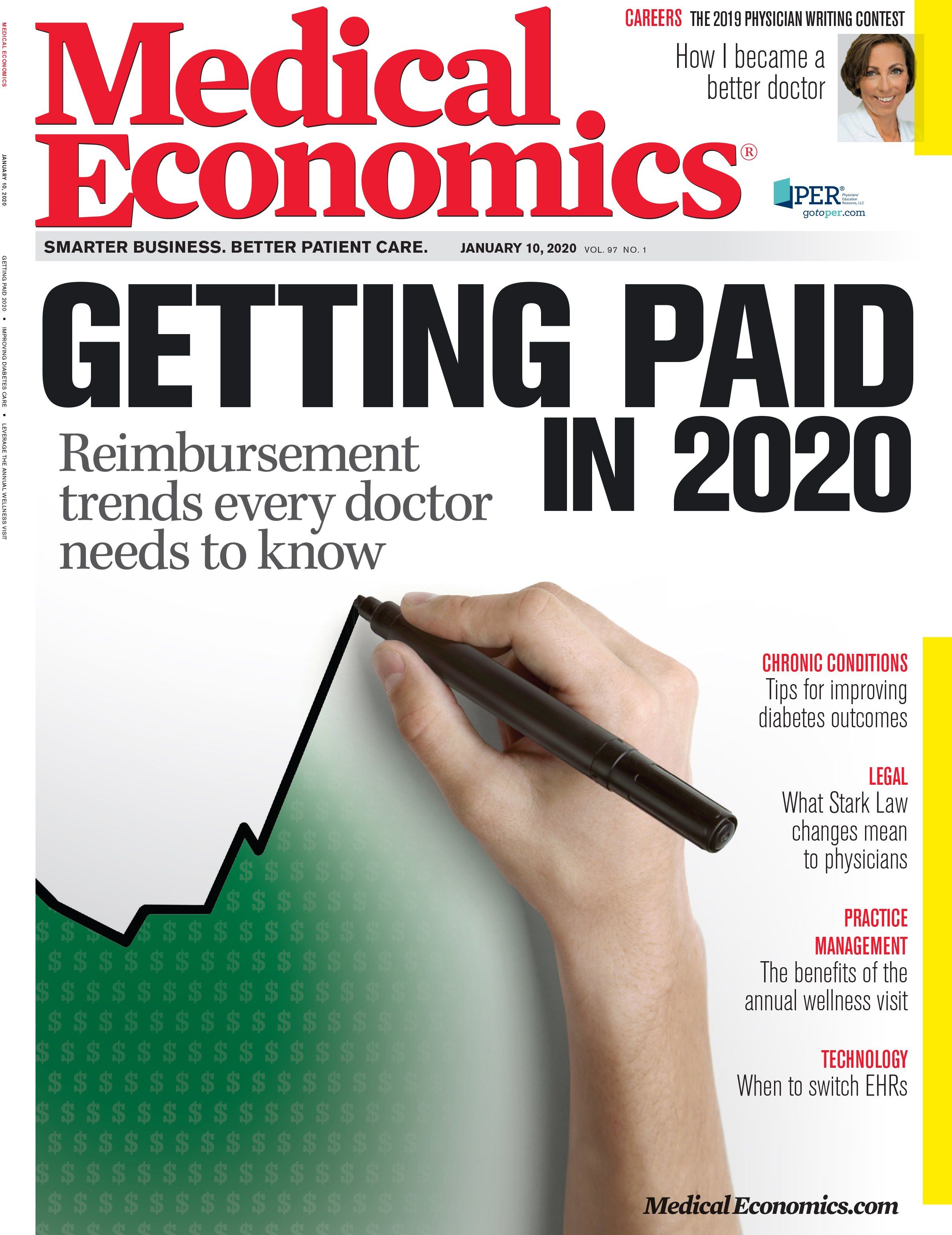Publication
Article
Medical Economics Journal
Getting paid in 2020 and beyond
Author(s):
Reimbursement trends every doctor needs to know

Reimbursement for independent physicians is getting more challenging each year. Between the ever-changing reporting requirements from CMS and contractual differences among commercial payers, just keeping up can be a full-time job.
Insurers are asking for more and more data to document patient outcomes and Medicare has its own reporting requirements through the Merit-based Incentive Payment System (MIPS). New payment models that emphasize primary care are in the works, so decisions doctors make today can affect their future income.
So what reimbursement trends should physicians expect in the near future?
CMS adds more emphasis to primary care
The biggest changes announced by CMS won’t take effect until 2021. The agency announced it has aligned its E/M coding requirements for office and outpatient E/M visits with those adopted by the American Medical Association CPT Editorial Panel. It is also retaining four levels of E/M codes for new patients and 5 levels for established patients. Earlier, CMS had proposed paying a single flat fee for E/M levels 2-4 and retaining a separate payment for level 5 visits.
For 2020, the Medicare Physician Fee Schedule conversion factor includes a small increase from $36.04 to $36.09. The last of the increases for inflation that were part of MACRA occurred last year, and physicians are now facing a six-year period with no inflation update, meaning the conversion factor is not expected to grow in any meaningful way.
“The reason for this is CMS envisioned there would be more movement to more Alternative Payment Models (APMs) and value-based care arrangements, but we haven’t seen that transition to the degree Congress wanted when it passed MACRA,” says Anders Gilberg, senior vice president, government affairs, for the Medical Group Management Association.
For those in MIPS, 2020 is an important year because of escalating penalties, says Gilberg. “Those who don’t report any quality measures at all in 2020, they’ll see a 9 percent reduction in their payments,” he says. “The potential bonus has yet to be determined (it was 1.65 percent last year) because it’s budget neutral, but it’s really important to focus on quality reporting in 2020 to avoid the negative payment adjustment in 2022.”
CMS always intended MIPS to be a feeder system into APMs that would have less reporting burdens and better-aligned financial incentives for each specialty, says Gilberg, but the number of APMs is limited.
“There’s always been a notion that CMS would go back to fee-for-service, reset the payment model (away from MACRA), or allow them to coexist,” says Ash Shehata, MHA, MBA, national sector leader for healthcare and life sciences for consulting firm KPMG. “2019 was the year of reality setting in.” MIPS isn’t going away, but the number and types of APMs isn’t sufficient to move physicians out of it, he adds.
As a result, CMS is pushing for better quality measures and more APMs and continues to move away from fee-for-service with payment models such as Comprehensive Primary Care Plus and the new Primary Care First program.
“The idea here is to move all physicians to more value-based payments,” says Cheryl Damberg, Ph.D., distinguished chair of healthcare payment policy at The Rand Corp. “There are still large numbers of physician practices that are not becoming part of groups and remaining independent. CMS is trying to experiment and figure out how to get them into the game.”
Primary Care Plus establishes patient-centered medical home-like payments and cost efficiency measures, while Primary Care First, which launches in 2021, builds on that idea and adds monthly capitated payments for patients.
While these new models may seem enticing, a practice needs to carefully consider why it would change its practice model. “For practices that are efficient and running a clean operation, they can make additional money,” says David Zetter, CHBC, founder and lead consultant at Zetter Healthcare Management Consultants. “They require proactive care management and the coordination of care-things most primary care practices don’t do. You have to have a staff to handle this, and it’s going to cost money. Don’t go in blindly and think you are going to get extra money just by changing your model.”
He advises thinking about what effect changing to a new model would have on both patients and the practice, and what the impacts on cost and quality would be. “Know your break-even point and if you’ll get a return on investment,” Zetter adds.
Private payers continue to push for value
Private payers have been increasingly paying for outcomes, and experts say this will not change in 2020 or beyond.
“Value-based care is where the excitement is,” says Shehata, who adds that private payers have been watching CMS experiment with more risk sharing and what results it has achieved. “If anything, what the CMS payment models have done is driven the industry to step up its capability to accelerate risk-sharing.”
In addition, provider networks are widening. “It’s no longer just the inpatient, outpatient, and primary care providers,” he adds. “Now, they are bringing in pharmacy, home care, and the entire continuity of care.”
Zetter says physicians need to pay attention to payment trends among private payers to make sure they are maximizing their reimbursement potential. “Private payers are looking for the same things as Medicare: patient access, engagement, low costs, and quality outcomes,” says Zetter. “They are looking for providers who participate in programs that meet all of those requirements.”
If doctors aren’t paying attention to costs-by, say, sending patients to a nearby imaging center instead of one that’s farther away but in the patient’s plan-the plan’s administrators will take a dim view of the physician and possibly terminate the contract.
“Several years ago, United Health dumped thousands of providers with no notice,” says Zetter. “They are allowed to do that if they don’t think you are participating and meeting the plan requirements the right way.”
Conversely, doctors who do exceptionally well with cost containment and patient satisfaction scores can be invited to join an exclusive provider organization and possibly earn bonuses.
“These are invite-only networks,” says Zetter. Invitees are high-quality, low-cost providers with good patient access, perhaps with evening or early morning hours. “Even in today’s age with retail clinics as competition, there are still primary care physicians that have banker’s hours and they wonder why they are not successful,” he says. “You have to look at what’s happening around you.”
He says that to maximize reimbursement, doctors have to pay attention to data in their EHRs and from payers so they understand costs and can help patients not only stay healthy, but help them manage costs. The better physicians are at reducing costs, the more attractive they are to payers.
“If a payer wants a provider that is exceptional, then they are going to do whatever they can to get that doctor into their network, including increasing reimbursement,” says Zetter.
Private payers are sharing data with primary care physicians faster and better than CMS, because they see the value primary care provides Gilberg says. “They understand where the savings take place,” he says. “They are focusing more on value-based programs in primary care and trying to provide information to extend a practice’s ability to enter into risk-based contracts.”
However, this shift toward value-based care has also increased prior authorizations and prepayment reviews. “It’s ironic, because value-based care was supposed to work because it holds the physician accountable for cost and quality,” says Gilberg. “There shouldn’t be a layer on top of that in order to send a patient for a test. The physician is already being held accountable.”
Payment challenges for smaller practices
Experts say mergers in the healthcare industry are likely to continue as payers try to find economies of scale and the right combinations to deliver on value-based care. “Larger organizations are better positioned to provide the infrastructure needed for value-based care that smaller ones may not have access to,” says Damberg. “But as more physicians have moved into bigger systems, they are having a hard time onboarding new physicians and getting them to sing out of the same hymnal and provide care in a coordinated way.
“It’s not a done deal that by merging into a larger system that physician performance is going to jump 20 points overnight and they’ll win the value-based care game,” she adds.
In fact, private payers don’t necessarily favor larger practices, because they have more negotiating leverage than smaller ones. Moreover, it’s still possible to make money in value-based care without being part of a larger group.
“A smaller practice, if they have a dedicated set of providers who are interested in providing value-based care, can be more nimble and do things more quickly if given the tools and resources to be more effective,” says Gilberg. “We see success on both sides, but a small practice is still typically disadvantaged.”
One way to minimize that disadvantage is to focus on either fee-for-service or value-based care, but not both, Gilberg adds. “If you are doing a little of both, the incentives don’t align with one another,” he says.
Another threat to small practice reimbursement is the rise of retail clinics. “The expectation is that these will be more efficient,” says Shehata. “Before we see any effect on pricing, we’ll probably see a more meaningful effect on the customer experience. The expectation is that patients will be able to shop across the market, and I think that will drive pricing and create transparency.”
Damberg says it’s probably too early to know how retail clinics will affect reimbursement rates, but it’s something the industry is closely watching. “Will they find less expensive ways to offer comparable services and maybe more conveniently?” says Damberg. “They may be more in line with what the next generation’s tastes are and how they consume products versus the traditional old-school model for practices. If they can walk into a doctor’s office in a mall and immediately get primary care services, that’s a potential game changer.”
One factor working in favor of physicians is their scarcity. “People underestimate the limited supply of physicians, and health systems have to compete pretty aggressively to keep these people,” says Damberg. “They have to stay competitive in how they negotiate with them, because they can’t afford to lose them.”
The number of smaller practices is also proving to be a reimbursement challenge for a market that wants to push more risk to physicians as part of their contracts. “There is still a lot of care provided by independent and small practices,” says Damberg. “That’s a big question mark for CMS and the commercial market in how to bring them along and control spending while still providing quality care.”






